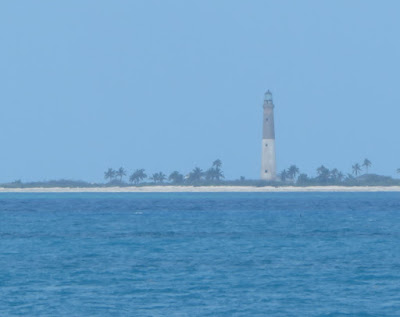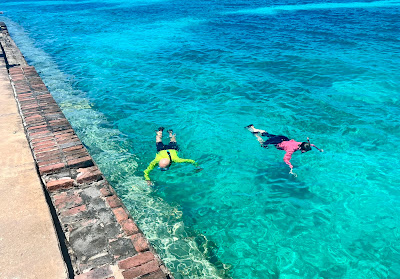 |
| Endangered Florida Thatch Palms |
Before settlers came to the Florida Keys there were areas
of abundant hardwood forest, that are called “hammocks”. 63 acres of hammock containing rare and endangered
trees and plants are preserved in the Crane
Point Hammock Museum and Nature Trails.
Native Calusa people were the first to use the area as a fish
camp, and left some artifacts behind.
Adderly House, the only tabby structure left in the Keys
The first permanent settlers were a Black Bahamian, George
Adderly, and his wife Olivia who purchased 32 acres of Vaca Key for $100 and
then built a tabby house in 1903. Tabby
is a kind of homemade cement made out of lime, created by burning wood and
shells at high temperatures, mixed with sand and water. Rocks and shells are put in to give it more
mass. The house is the oldest house in
the Keys outside of Key West and the only tabby house remaining in the Keys. The house has two main rooms and two
bedrooms.
 |
| Adderly used this "creek" between Vaca and Rachel Keys to navigate to Florida Bay to havest sponges and to sail to Key West |
Adderly collected sponges and made charcoal, and sailed his
boat periodically to Key West to sell them and buy provisions that he and
Olivia could not make on their own. When
the railroad came through, he negotiated a right of way that included a stop on
Vaca Key, so he could use the railroad to travel to Key West more efficiently.
 |
| This guy came to visit us at Adderly House. We were told that racoons don't carry rabies in the Keys. |
George Adderly was an Episcopal lay preacher who held services in his home. At some point, a few other families built wooden houses near his on Vaca Key, forming Adderly Town. All that remains of these homes are a few tools and household utensils found on the property.
 |
| Built in the Bahamian style, every door or window has a corresponding opening on the other side for ventilation. |
Olivia died in 1948 and George sold the property to the Crane family in 1949, moving to a home for the blind in Key West, where he died ten years later.
Francis and Mary Crane were a Massachusetts couple who fled
the New England winters, much as many “snow birds” do today. They purchased Rachel Key in 1949. When they purchased the adjoining Vaca Key
from Adderly, they consolidated 63 acres of natural hammock. The land was renamed Crane Point, and they
built a house overlooking Florida Bay in 1954.
Crane Point (with old work boat)
The Cranes worked to preserve the special ecology and beauty
of their wooded hammock. All around
their oasis, forests were being bulldozed in Marathon to make way for homes,
hotels and businesses as more people discovered the Keys as a destination.
In 1978, the
property was purchased by the newly formed Florida Land and Sea Trust to
protect it from development. The Crane
Point Hammock Museum and Nature Trails has a natural history museum, the two
historic houses, several miles of nature trails, and other educational and environmental activities. Both the Adderly House and the Crane House are
on the National Register of Historic Places.
You can walk through the Adderly House.
The Crane House has scheduled tours.
The museum has beautiful bronze doors
It was too windy to be out on the water, so we decided to head into
Marathon to explore Crane Point, go grocery shopping and have lunch at a Cuban
restaurant. Crane Point has well
maintained hiking trails that take you through the forest, past the historic
houses, and along the point.
You can learn about interesting trees through signs along the way.
Black Mangrove "straw" roots snorkel up out of the water or mud to get oxygen
Crane Point is right off of Route 1 in the center of Marathon. There is a shopping center with a grocery
story directly across the street.
Marathon is a busy city at the north end of the 7-mile Bridge with an
airport, hotels, time shares, condos, restaurants and businesses.
After spending so much time on the edge of the ocean, it was really fun to have closer vistas of dense foliage, and the background songs of birds. We love the stories of these kinds of parks, where individuals work to preserve a special, natural place.

















































